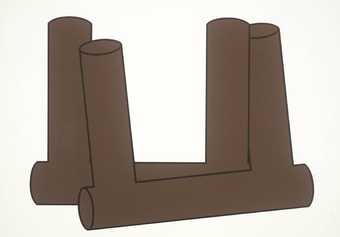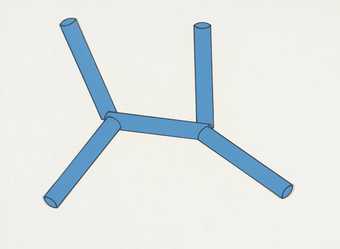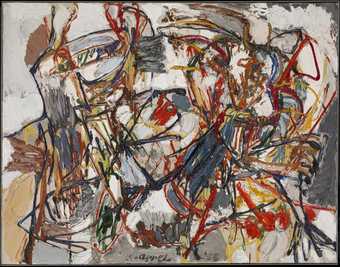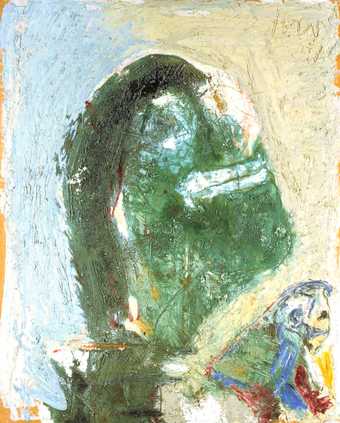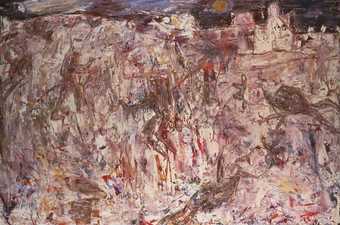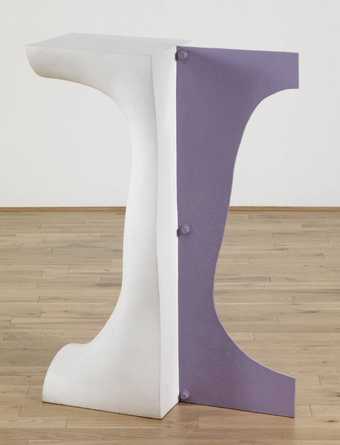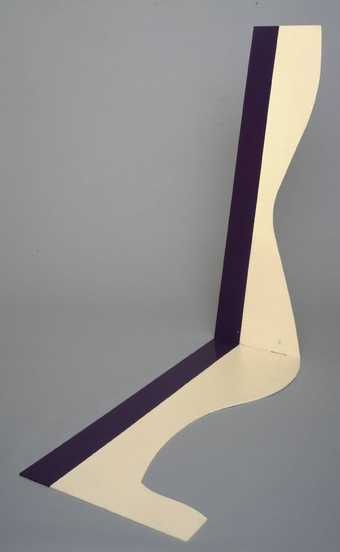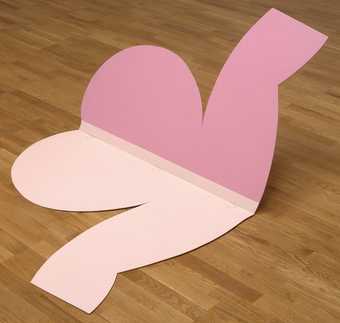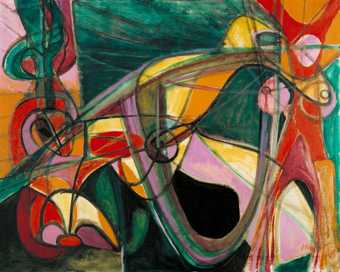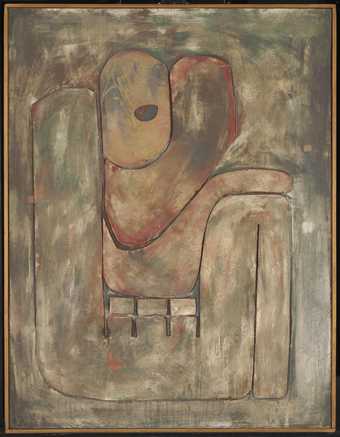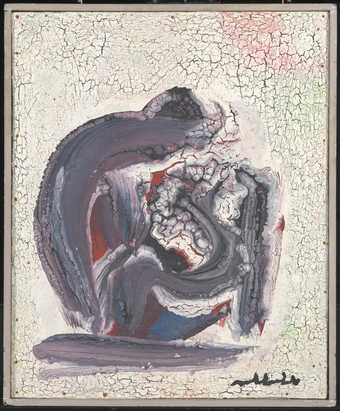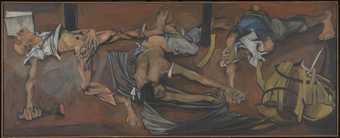
In Tate Modern
- Artist
- Hamed Abdalla 1917–1985
- Original title
- Mahzoum
- Medium
- Silver, aluminium, tar and oil paint on board
- Dimensions
- Frame: 633 × 745 × 42 mm
- Collection
- Tate
- Acquisition
- Presented by the executors of the artist’s estate 2014
- Reference
- T14314
Summary
Defeat 1963 is an abstract painting on board in silver leaf, aluminium, paint and tar. The silver leaf has been overlaid with aluminium, creating a highly textured and strikingly bright surface. A blowtorch has then been applied to this base layer in order to create scorch marks on the silver and aluminium ground. The composition was finished with a combination of black paint and tar which create abstract calligraphic forms. The effect is a contrasting composition of elements and textures, as well as burnt and bright surfaces, resulting in a visually rich painting that is reminiscent of the effects of fire while still bearing the luminosity of silver.
This work is characteristic of Hamed Abdalla’s practice in the early 1960s. The unconventional materials and technical expression testify to his liberation of forms through the destruction or alteration of the material qualities of his media; a trajectory which Abdalla continued to explore throughout his career. However, the use of tar in this work is unique within the artist’s practice. It defined an important shift in his technical evolution and his application of different textures, colours and materials. The formal development of his paintings at this stage (which were dominated by burnt surfaces), as well as his choice of materials, exemplified a departure from his usual experimentations with conventional paint, which had a lighter, gestural feel.
Defeat is part of the series Illuminations which Abdalla worked on from 1963 (the year he made Defeat) to 1966, while he was living in Copenhagen. The series defines one of the most original and radical moments in his diverse practice. Initially trained in calligraphy in Egypt, but frustrated by the political and social situation in his home country, Abdalla settled in Copenhagen, where he experienced a period of intense experimentation and discovery. The ideas that had pervaded the work of the CoBrA artists (based in Copenhagen, Brussels and Amsterdam) were still prominent at this time in the local and international context. Their concepts of freedom of form and colour had a significant impact on Abdalla, who shared CoBrA’s fascination with scrutinising familiar methods and radically exploring new artistic forms.
Abdalla pioneered a practice based on continuous experimentation with the concept of the ‘word-form’, which combines in painting the use of shapes, colours and forms to achieve visual effects that allude to written words. His use of anthropomorphic shapes, symbols and forms of writing reveals the nature of linguistic traditions, displacing habitual understanding and integrating language into the fabric of conceptual thinking. Words such as ‘sadness’, ‘capitulation’, ‘slavery’, ‘prostration’, ‘pain’, ‘war’, ‘defeat’, ‘resistance’, ‘revolution’ and ‘freedom’, but also ‘love’, ‘affection’ and ‘desire’, are among the terms widely used in his symbolic statements, becoming quintessential features of his practice.
While in Europe, Abdalla remained engaged with political developments in Egypt. The 1950s and 1960s were marked by conflicts throughout the Arab world and Egypt was no exception. The Suez Crisis of 1956, the subsequent political humiliation of Egypt’s president Gamal Abdel Nasser and the abandonment of the Unity of Nations ideals had a distinct impact on Abdalla’s creative output. Reflecting on political failure, but also on the spectre of poverty that haunted his country, Defeat describes a scene that, although abstract, can be pictured by the viewer. The word defeat seems to be embodied in the calligraphic black forms which can be read as hunched or beaten down silhouettes. The word itself can be distinguished written in tar and abstracted or expanded through the burning process. The overall effect is a dramatic impression of the subject matter which blurs the boundaries between abstraction, figuration and language. Like other works by Abdalla in which linguistic meaning is presented on the pictorial plane to be discovered in anthropomorphic forms, Defeat functions at the boundary between visual and verbal forms of expression.
It was not just his association with CoBrA that made the period between 1956 and 1966 important in Abdalla’s career. With his work gaining international attention, Abdalla sought to expand his vocabulary, challenging the conventions of formal composition and language and creating a highly idiosyncratic practice. On the occasion of an exhibition of his work in Odense in 1965, the critic Ib Paulsen wrote:
Abdalla is an artist in the best meaning of the word. He works creatively and with a great textural fantasy, in such a way that his choice of unfamiliar materials has just as natural an effect as his use of the familiar. For instance, some of his works in aluminium colour and pitch, worked together by means of a blow-torch, have a great effect … His pictures stand mostly as modern hieroglyphs forming a firm composition.
(Quoted in El Zein 2014, p.90.)
Further reading
Roula El Zein (ed.), Abdalla, L’oeil de l’esprit, Paris 2014.
Vassilis Oikonomopoulos
July 2014
Does this text contain inaccurate information or language that you feel we should improve or change? We would like to hear from you.
Display caption
Abdalla experimented with unusual materials and techniques. He made Defeat by overlaying silver leaf with aluminium. He then used a blowtorch to burn areas on the bright surfaces. Marks resembling writing overlay the composition. He made these with a combination of black paint and tar. Abdalla moved from Egypt to Denmark in 1957 and later lived in France. But he remained engaged with political developments in his home country. Much of his work reflects on political failure and the impact of conflict.
Gallery label, June 2020
Does this text contain inaccurate information or language that you feel we should improve or change? We would like to hear from you.
Explore
- abstraction(8,615)
-
- from recognisable sources(3,634)
-
- figure(2,270)
- non-representational(6,161)
-
- gestural(891)
- emotions and human qualities(5,345)
-
- suffering(161)
- vulnerability(311)
- texture(466)
- military(301)
- actions: postures and motions(9,111)
-
- bending forward(353)
- figure(6,809)
- countries and continents(17,390)
-
- Egypt(98)
- inscriptions(6,664)
-
- Arabic text(23)
You might like
-
William Tucker [no title]
1968 -
William Tucker [no title]
1969 -
Karel Appel Amorous Dance
1955 -
Asger Jorn The Timid Proud One
1957 -
Jean Dubuffet The Busy Life
1953 -
William Tucker Margin I
1962 -
William Tucker Margin II
1963 -
William Tucker Unfold
1963 -
Stanley William Hayter Untitled
1946 -
William Tucker Tunnel
1972–5 -
André Masson Star, Winged Being, Fish
1955 -
Nil Yalter Temporary Dwellings
1974–2005 -
Hamed Abdalla Lost or Escaped
1966 -
Hamed Abdalla Meditation
1969 -
Peter de Francia The Execution of Beloyannis
1953–4

